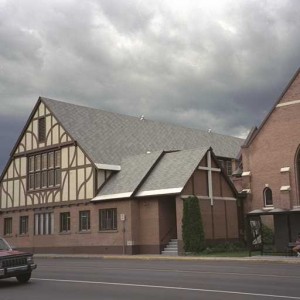First United Church
Place Description
The historic place is the First United Church and the adjacent church hall and Sunday school, begun in stages between 1909 and 1929 in the Gothic Revival and Tudor Revival styles, and located at 721 Bernard Avenue, at the corner of Richter Street, in Kelowna's historic North Central neighbourhood.
Heritage Value
The First United Church has architectural value for its distinctive architectural quality, its having been a product of work by important local architect and builders, and its landmark status. It has historical value for its long-standing place in the community, including its association with specific people and events that were significant in the history of the City; and it has provincial value for its role in Church Union.
The prominent church, built in 1909 during the first wave of development in the young City of Kelowna, is a highly significant heritage resource because of its stalwart Gothic Revival design and its strong architectural presence. The large brick church is also a neighbourhood landmark that marks the dividing point between the commercial and residential sections of Bernard Avenue, and is the main landmark in the area.
This dominant position has been held since the first church was built at this location in 1898. A.B. Knox, pioneer rancher and owner of land to the east of the Kelowna townsite, had donated a large lot at the corner of Bernard Avenue and Richter Street to the Presbyterians two years earlier. The first, wooden, Knox Presbyterian Church was built there by prominent builder M.J. Curts; the name was apt, as Knox had a distant family relationship with John Knox, the Scottish religious reformer for whom the church was named. The church was part of a 'student field,' which included the Benvoulin Church, until 1905, when Kelowna's Presbyterian congregation became self-sufficient and separate.
The present building, the second Knox Presbyterian Church, was designed by architect Wesley A. Peters, who designed two other churches in Kelowna at this time; and was constructed in local brick by prominent builder Harry W. Raymer in 1909-10. It has value as a very good example of the late Gothic Revival Style, a manner in which the Gothic historicism is set within a restrained, almost proto-modernist architectural treatment.
Sunday school rooms were built in 1919 and 1920 (the later built by M.J. Curts). The Tudor Revival school and hall, built in 1928-29 and enlarged in 1947, expanded the Sunday school and provided a hall for many other community activities. The hall remains a popular venue for general secular community activities, as well as for the Church.
The building also has value for its role in the formation of the United Church of Canada. The Reverend Alexander Dunn, who served as minister from 1912, returned from a Presbyterian General Assembly in Winnipeg in 1916 so fired with the idea of Church Union that he immediately resigned to make union possible in Kelowna. As a consequence the Union Church of Presbyterians and Methodists came into being, one of the first union churches in British Columbia. In 1926 the United Church of Canada was formed, including Congregationalists as well, and the building became the First United Church.
The First United Church seized the opportunities of new technology. When the radio station 10-AY (predecessor of CKOV) started broadcasting in 1928, among its first regular programs were morning and evening services from the Church every second Sunday, as well as many concerts put on by the Church to help raise money for equipment upkeep for the station.
Character Defining Elements
- Prominent location at the intersection of Bernard Avenue and Richter Street
- Building mass dominates the open view at the intersection
- Asymmetrical plan, with a corner entry through the base of the tower
- Gothic Revival features, including pointed-arched (and segmental-headed) doors, pointed-arched stained-glass windows, buttresses, gables, and crenellated tower.
- Buttresses are stepped, with sloped coping at each step
- Light brown brick church walls with cream concrete trim
- Large stained-glass windows that dominate the two main church facades
- Stairs with parapets leading up to the principal doors
- Tudor Revival Church Hall and Sunday School, which are sympathetic in massing with the Church, and which has features of that style, such as the decorative half-timbering and vertically-oriented windows
- Landscaping with trees and shrubs at small open corner
- Fieldstone retaining wall along narrow raised landscaped beds on Richter Street






